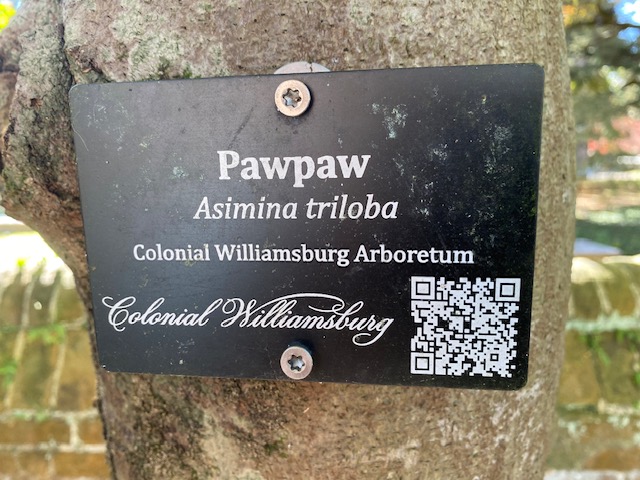Secrets in the Pawpaw Patch
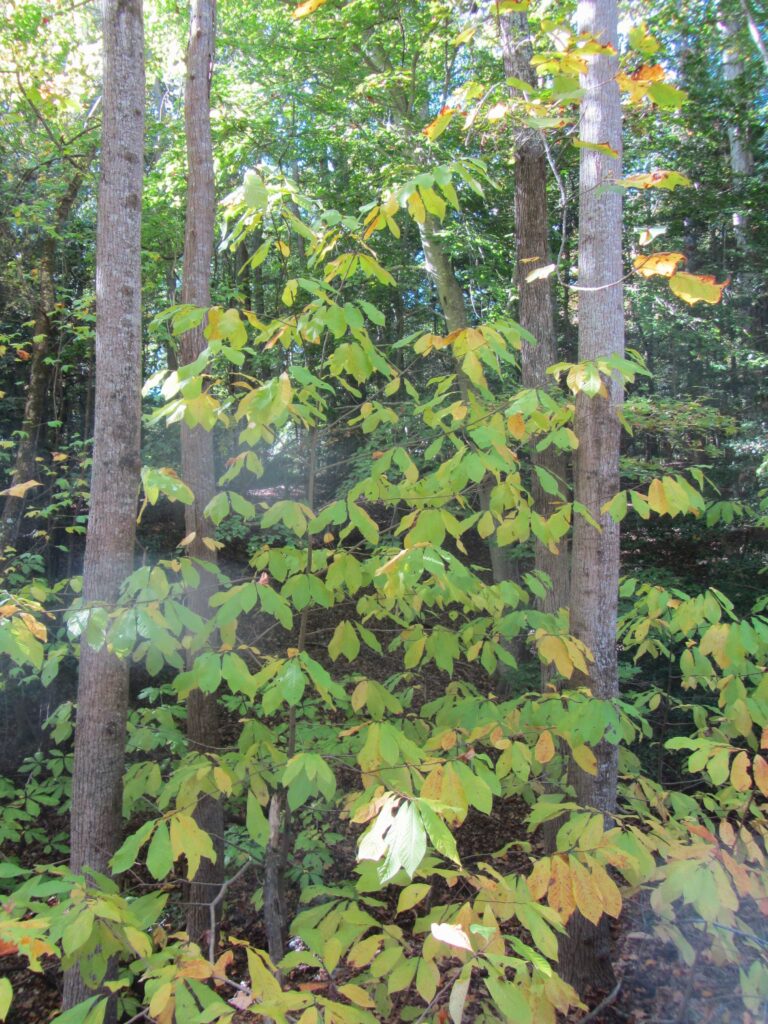
Asimina triloba, pawpaw, grows along the Colonial Parkway.
If you happen to come across a pawpaw patch in the springtime, when the trees have covered themselves in small, deep red blossoms, please don’t be tempted to step closer to smell the flowers. Admire them from afar. Zoom in to take a photo. Like skunk cabbage and jack-in-the pulpit, pawpaw flowers have a putrid odor to attract the flies and beetles that pollinate them, and the dull color of their flowers resembles rotting meat.
Pawpaw’s small flowers, rarely larger than a half-dollar, have six petals. Three smaller inner petals form the points of a triangle nestled within three larger outer petals, also forming a triangle pointing in the opposite direction, when fully opened. Together they form a hexagram, the six-pointed star, an ancient symbol of protection. These are ‘perfect’ flowers, having both male, pollen bearing stamens and a female pistil, whose base will develop into the fruit after about five to six months of growth.
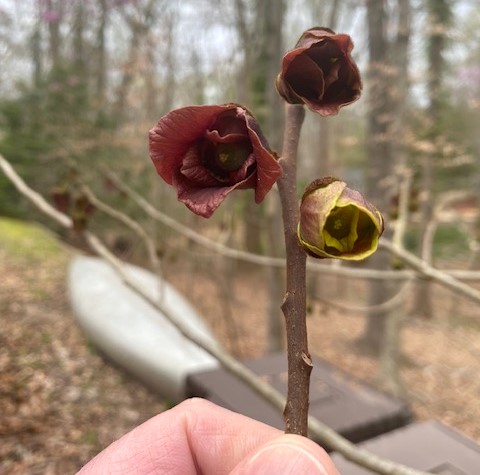
Pawpaw flowers bloom along the Bassett Trace Trail at Colonial Williamsburg. Photo courtesy of Rick Brown, Master Gardener Tree Steward and Master Naturalist.
Secrets in the Pawpaw Patch, Quick Notes Version
Pollination Challenges
Yet the flowers of most pawpaws aren’t self-fertile. And since pawpaw trees grow in patches of clonal duplicates of the same plant, emerging from a single root system, they require fertilization with a flower growing a bit further away that is from a genetically different plant. Since the pawpaw relies on beetles and flies for pollination, pollination can be spotty some years. But should a late freeze kill the flowers, the pawpaw tree has a superpower that apples and other orchard fruits lack. The pawpaw can bloom again in the same spring, with a second flush of flowers.
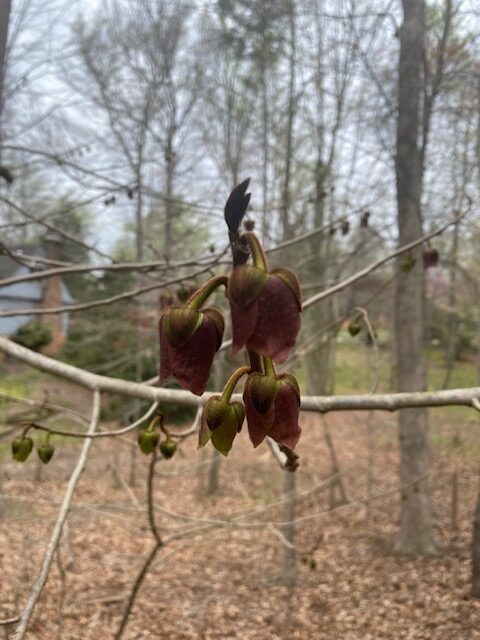
Pawpaw flowers often point downwards, making it even more challenging for insects to pollinate them. It is unlikely they will be pollinated by the wind. Photo courtesy of Rick Brown, taken along the Bassett Trace Trail, Colonial Williamsburg.
Growing in the Shade and Shadows
The pawpaw tree, an understory tree native to Eastern North America from southern Canada south to northern Florida, often grows in the shade and shadows of other, larger trees. It grows in clearings, along stream banks, on the sides of riparian ravines, and along roadsides. Its distinctive large, oblong, simple leaves give it away to those who search for it. The tree’s leaves look tropical, ending in tips designed to shed rain, like many leaves growing in tropical rainforests. Its leaves may grow to 12” long and 3” wide by early summer, hanging like pendulums swaying in the wind. The leaves have a fragrance too, if you crush them slightly. They smell a bit like green peppers.
If you happen to come across a pawpaw patch in the springtime, when the trees have covered themselves in odiferous, red flowers, make a note to return in late summer or fall to gather its delicious fruits. They ripen from late August through early October. Pawpaw fruits are rare and precious, hard to find and wonderfully delicious. Indigenous to 26 of our United States, native Americans valued and cultivated pawpaw trees for many centuries before European colonists learned of them.
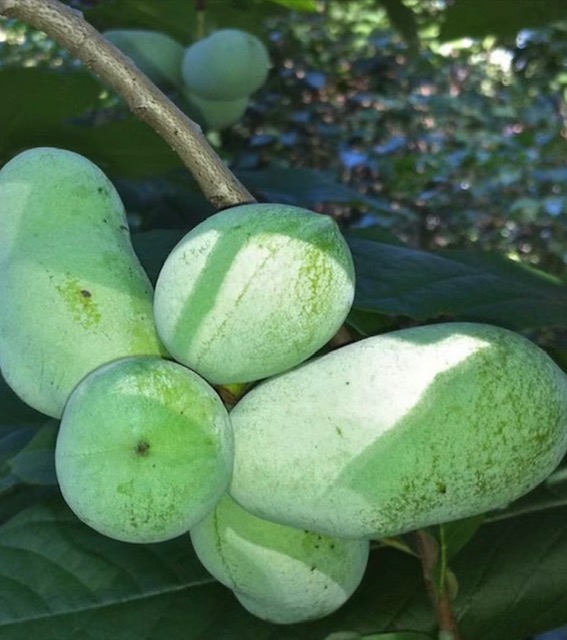
Pawpaw fruits grow in clusters. Photo courtesy of Shirley Devan, a Master Naturalist volunteer Trail Guide on Bassett Trace at Colonial Williamsburg.
‘Assimina’ Was Cultivated by Native Americans
The genus name, Asimina, sounds like the name given to pawpaws in several native languages. Virginia colonists recorded in 1612 that the Powhatan tribes they encountered called the fruit ‘Assimina.’ The species name, triloba, refers to the three lobes within each fruit, and also to the shape of the pawpaws’ flowers. The common name, pawpaw, likely comes to us from some Spanish explorers’ confusion between the North American native Asimina fruit and the papayas they had eaten elsewhere on their voyages. Pawpaws were first mentioned in the 1541 records of the Hernando de Soto expedition, because they found native communities cultivating these fruits east of the Mississippi River.
We know from historical records that the first Asimina orchards in North American were cultivated by native Americans, who depended on their fruits for food. Pawpaws are the largest indigenous fruit in North America. According to Kentucky State University, pawpaws have more protein than apples, oranges, or bananas, with measurable amounts of 11 amino acids. They also contain a variety of fatty acids, Vitamins A and C, 8 minerals, and a good amount of fiber.
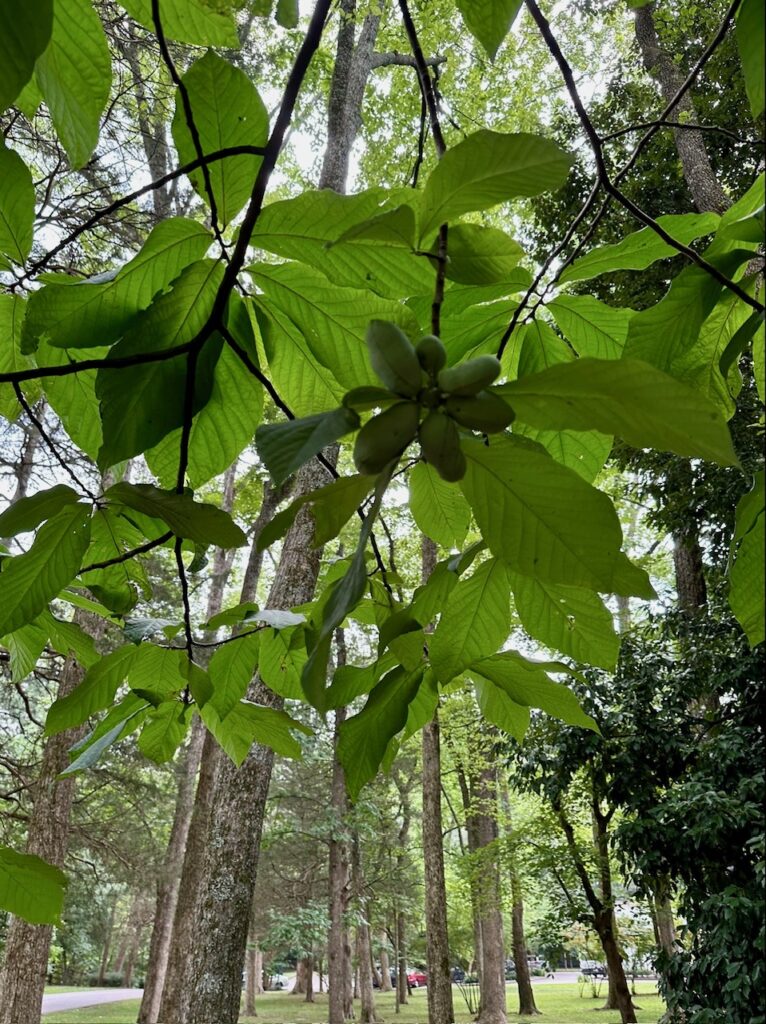
Pawpaw fruit are still ripening in late July. The Griffin Hotel grounds at Colonial Williamsburg. Photo courtesy of Dave Kleppinger, Master Gardener Tree Steward.
Eating Pawpaws
Only the custardy flesh of the fruit should be eaten as both the peeling and seeds contain acetogenins which cause digestive pain. The tree’s bark, stems, and leaves are also inedible, though native American medicine people found uses for some parts of the tree other than the fruit pulp. The fruit is delicious raw. But it can also be frozen into custard or baked into deserts. George Washington loved the raw, chilled pawpaw pulp for desert. He purchased one of the first mechanical ice cream machines in the mid-18th century and may have enjoyed pawpaw ice cream. Both George Washington and Thomas Jefferson cultivated pawpaw trees on their estates.
Colonists at Jamestown would have learned to eat pawpaws as did other colonists along the East Coast of the United States. Lewis and Clark relied on pawpaws, especially when their provisions ran low, during their expedition westwards to explore the Louisiana Purchase in 1804-1806. Adventurers, explorers like Daniel Boone, and soldiers throughout our history have sought out pawpaw trees as the fruits ripen in autumn.
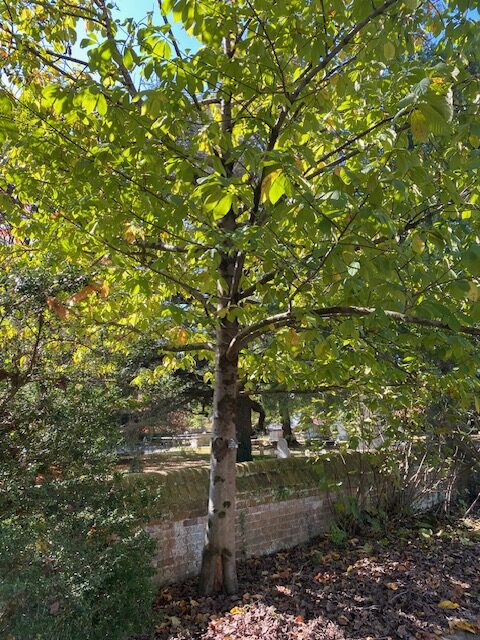
Asimina triloba grows at the George Wythe house, next to the wall at the Bruton Parish cemetery in October 2024. This tree is a part of the Colonial Williamsburg Arboretum. Photo courtesy of Rick Brown
The Most Delicious, Yet Unknown Fruit
Pawpaw fruits have remained something of a secret, a little-known treat rarely found in farmer’s markets and almost never in a grocery store. Pawpaws ripen quickly, bruise easily, and haven’t been the subject of serious research and improvement until recent decades. Kentucky State University conducts most current agricultural research on Asimina triloba. While other native trees and vegetables were improved, selected, marketed, and put into commercial production long ago, Asimina has proven more elusive.
West Virginia native Neal Peterson fell in love with the taste of wild pawpaw in 1975, while he was a graduate student at West Virginia University. He realized that no one else was doing the work to breed a better pawpaw and began searching out heirloom pawpaw varieties known for their high quality fruit. After many years of searching out pawpaws, collecting seeds from the best fruits, and embarking on his own breeding program, Peterson, also known as ‘The Johnny Appleseed of Pawpaws,’ has trademarked more than 15 pawpaw varieties and licenses them to commercial nurseries to propagate and sell. All of his varieties are named for American rivers along which pawpaw trees grow.
Propagation Challenges
Pawpaw breeding and propagation offers many challenges. First of all, Asimina triloba seeds can be difficult to germinate. Most (except seeds taken from trees growing in the far southern portion of their range) require cold stratification and can take a year or more from harvesting the seeds to tending a seedling. And then, those seedlings aren’t true to the parent trees. A seedling tree may not bear fruit for its first 8-10 years and fruits growing on different branches of the same seedling tree may be different from one another.
Stem and root cuttings are difficult to impossible to propagate, especially cuttings taken from trees more than a year or so old. Grafting cuttings onto rootstock is the most reliable way of putting named cultivars of Asimina into production. There are at least 10 named cultivars marketed for our area, according to NC State University. At least five of those listed were developed by Peterson. Kentucky State University lists 27 commercially available pawpaw cultivars.
Commercial Production of Pawpaw Fruit
More farmers and orchardists are experimenting now with planting pawpaw orchards for commercial production, using superior cultivars. As weather has become more unpredictable, many fruit growers have had crops of apples, pears, peaches, and plums damaged or destroyed by everything from late heavy frosts to flooding, hurricanes and tornadoes. Extreme cold and heat, flood and drought take their toll on agriculture each year, but fruit and nut bearing trees in commercial production have experienced catastrophic losses in recent years due to weather, insect damage, and microbial disease affecting these trees. Destructive insects and diseases are moving into new territories as the climate warms. Growers expect that Asimina trees will be resilient and productive, and prove a good investment.
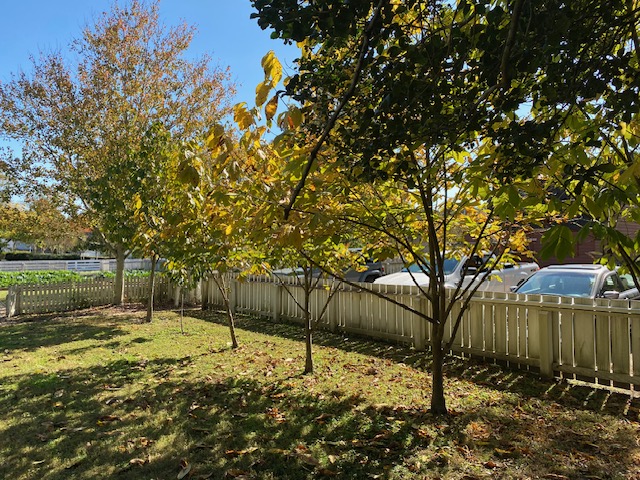
The pawpaw orchard of eight trees adjacent to the Catherine Orr garden in Colonial Williamsburg. Photo courtesy of Rick Brown
Growing Asimina Trees
Native Asimina is highly adaptable to growing conditions on many types of soil, including wet soils, from the mountains to the coast, from deep shade to full sun, in Zones 5a-9. They tolerate occasional drought with their extensive root systems and seem impervious to insect damage and disease. While they prefer acidic, woodland soil, they will grow in more neutral soil. Asimina produces its best fruit when cultivated in full sun with genetically different pawpaw trees growing nearby for cross-pollination.
The height and spread of Asima depend on the amount of light and space available to it. Grown in full sun, without competition from other tree species, an Asimina may grow to 30’ tall and wide over a decade or more. Mature trees as tall as 45’ have been documented in optimal conditions. When grown in low light, or on the edge of a shady area, the tree will reach for the sun, sometimes even growing nearly horizontally and not reaching more than 15’ tall.
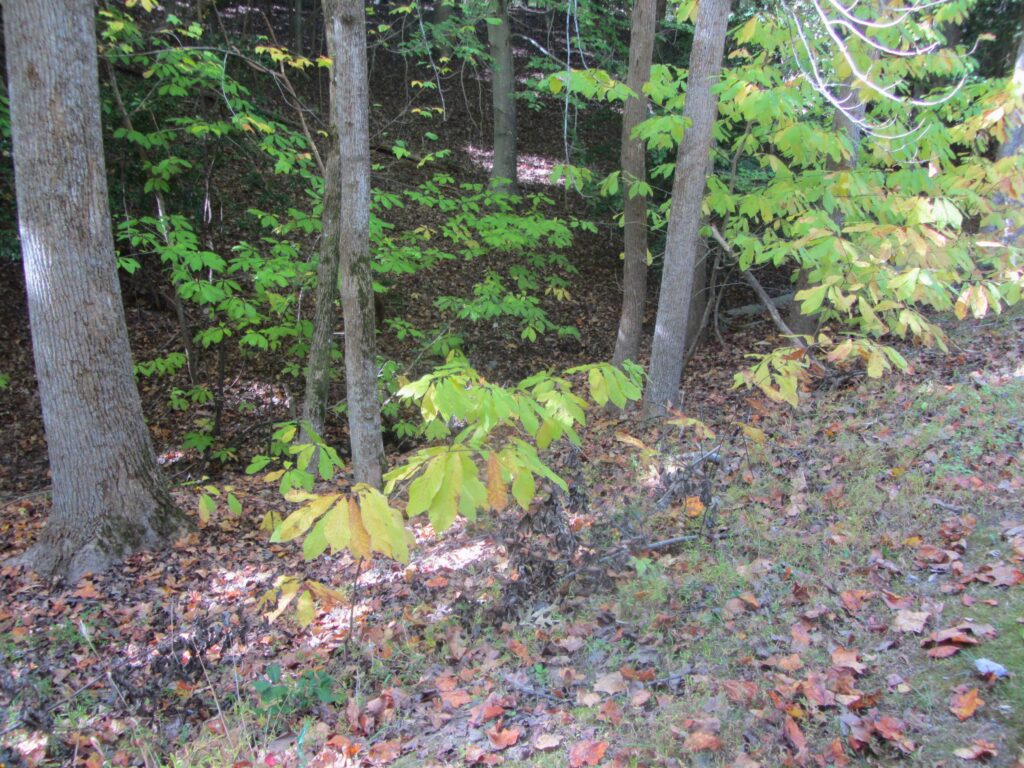
Look along the shoulders of the Colonial Parkway, and in the nearby ravines, to find patches of pawpaw trees. Their large, yellow leaves make them easy to spot in autumn.
Practical Uses for Asimina Trees
Asimina trees are an excellent choice for ‘pick-your-own’ orchards and growers near farmers’ markets where fruit can be sold fairly close to the orchard. They are also an excellent selection for public parks and community food gardens. Home growers wanting to grow their own ‘food forest,’ and who have space to allow the trees to sucker and spread into a ‘pawpaw patch’ will also enjoy these beautiful, healthy trees and delicious home-grown fruits. Fruit refrigerated before it is fully ripe will keep several weeks, refrigerated, and can be allowed to finish ripening at room temperature. Just keep in mind that a tree may take 8-10 years after it is planted to become productive.
Native Americans also used Asimina wood for making baskets and tools. They used the stringy inner bark for making fibrous rope, mats, and even fish nets. The rot resistant wood is good for making fences. Many parts of the tree, including its leaves, can be used to make a natural insecticide. This tree’s leaves, bark, seeds, and fruit peelings contain Annonacin, a neurotoxin. Annonacin has been linked to Parkinson’s disease among some Caribbean islanders who regularly eat the fruit or drink a calming tea made from leaves of the related soursop and sweetsop trees. This is another reason why pawpaw seeds and peels should not be eaten.
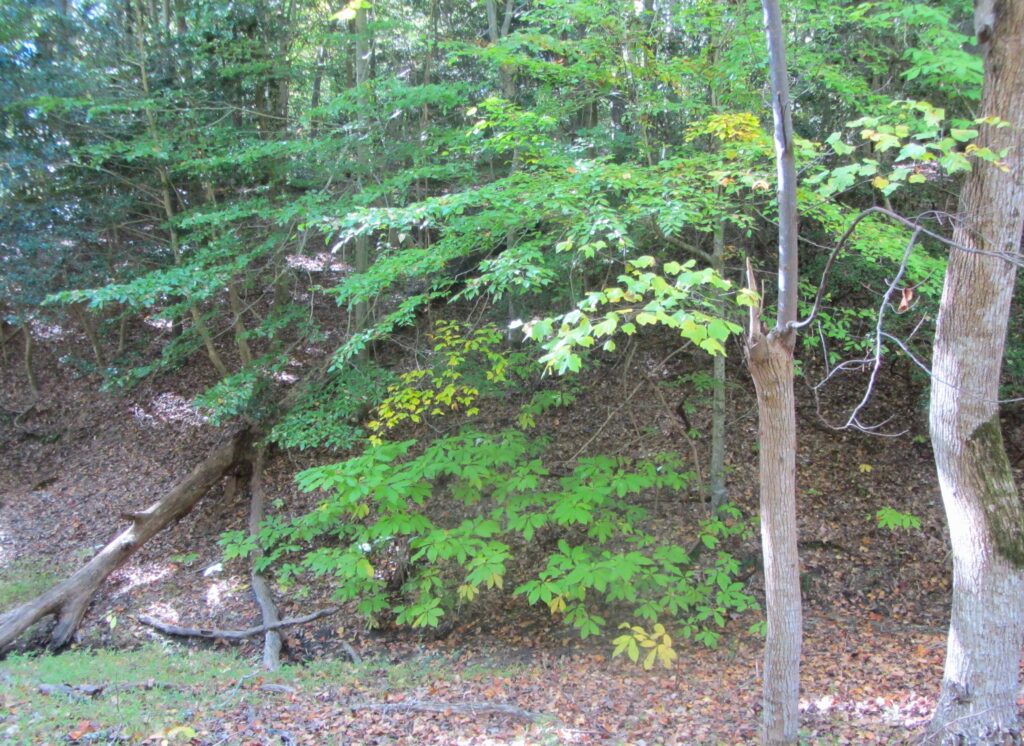
Find pawpaw patches in the wild growing on slopes near creeks, rivers, and ditches. They appreciate the moist soil and grow well in partial shade as understory trees.
Environmental Benefits of Asimina Trees
Pawpaw trees serve as a host plant for the Zebra Swallowtail butterfly. But the swallowtail caterpillars do little or no damage to a tree’s leaves and don’t affect fruit production. The trees are not grazed by deer, but a variety of wildlife are happy to forage fallen, ripe pawpaws as well as their immature fruits. Squirrels often harvest unprotected pawpaws from back yard orchards and wild stands of trees just before the fruits ripen enough for human taste. This is an excellent tree to include in a wildlife garden, or in wilder areas of a large yard, particularly on a property that borders wetlands. It is an excellent choice for riparian restoration projects as its extensive root system helps hold ground against erosion.
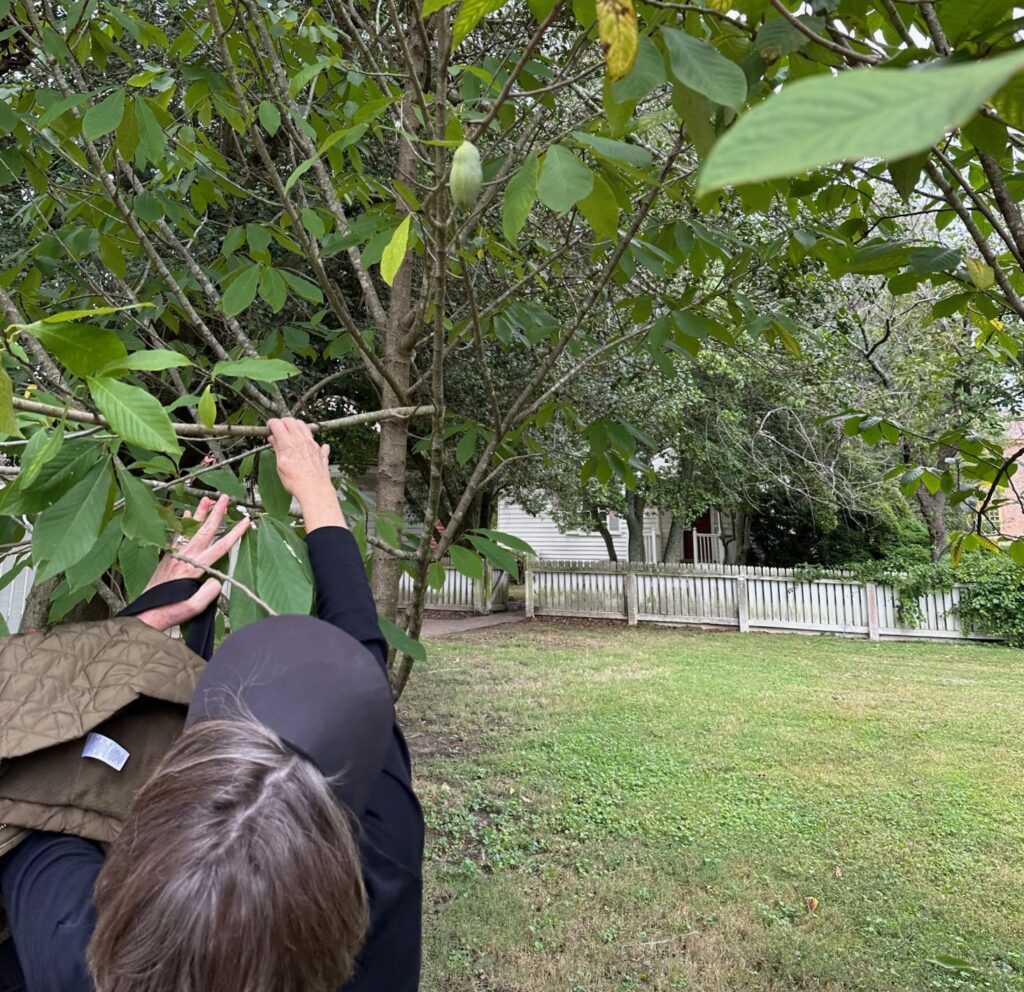
By late September, only a single pawpaw is left on the Asimina trees growing in the Catherine Orr Garden at Colonial Williamsburg. Photo courtesy of Dave Kleppinger.
Pawpaw Trees in Our Region
Asimina triloba is the only temperate North American genus in the Annonaceae, or custard apple family. Most genera within this family are tropical or sub-tropical. If the leaves remind you of a Magnolia’s leaves, it is because Asimina belongs in the same Magnoliales order of plants as our common Magnolia trees. Asimina parviflora, the dwarf pawpaw, grows to only 6’-8’ and bears smaller fruits in Zones 7-10. It can grow on sandy soil. Either species will grow well in our area.
Pawpaw trees grow wild in the Williamsburg area in ravines, along roadsides like the Colonial Parkway, and in parks and neighborhoods. You will find pawpaws in cultivation at Colonial Williamsburg at the George Wythe House and a collection of eight trees in the Catherine Orr Garden.
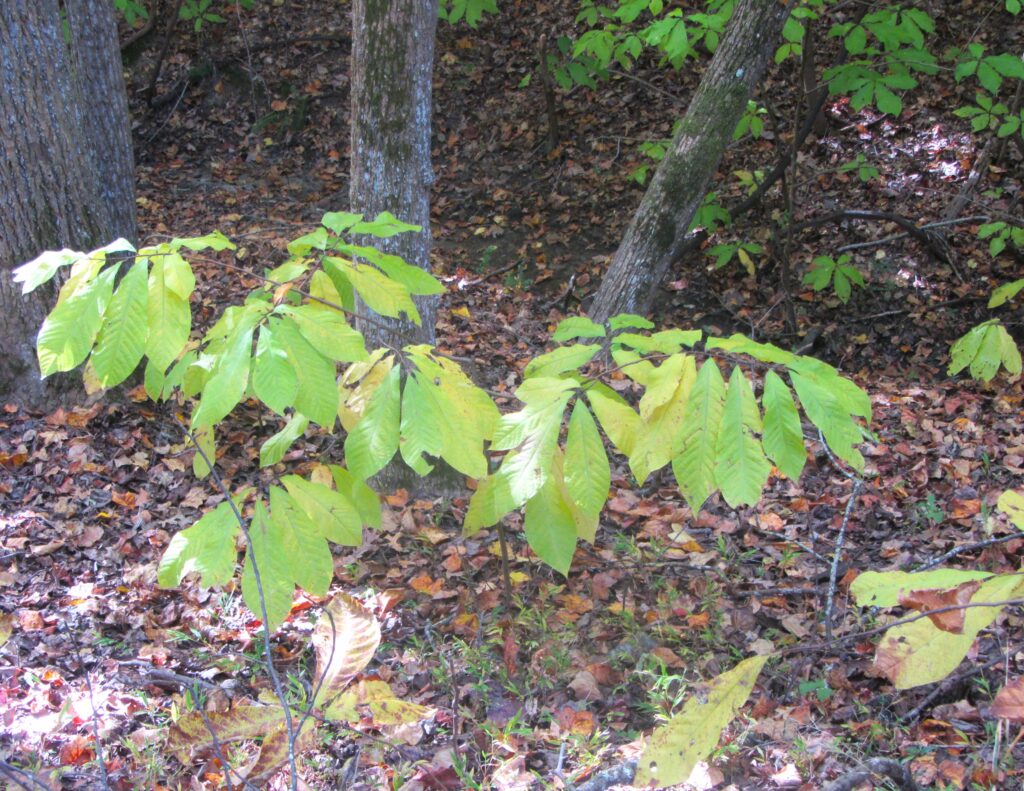
Young trees may sprout as suckers growing from the roots of more established trees. A single pawpaw tree can grow into an expanding patch of trees all sharing a common root system.
How to Grow Your Own Asimina Trees
While the large, now extinct mammals like mastodons and wooly mammoths which at one time spread these relatively large seeds no longer do so, bears will eat pawpaws and can spread their seeds. Human activity still ensures that pawpaw seeds are saved and cultivated. You can certainly collect pawpaw fruit in autumn and plant those wild seeds, but you will likely harvest better quality fruit if you order a named cultivar from a nursery that specializes in native plants and fruit trees. Autumn is the best season for planting trees in our area, so they can establish their roots before summer heat and drought.
If you want to try to grow Asimina trees from collected seeds, understand that they need around 110-120 days of cold stratification to germinate. An easy method is to first clean the seeds and then soak them for at least 8 hours in water. Pour boiling water over the seeds in a heat proof container, and allow it to cool.
Next, drain the seeds and place them in a zip-lock baggie with damp sand or vermiculite. You could wrap them in a damp paper towel instead, before placing them in the baggie. Write the date on the bag and then count forward 110 days and write the date to remove them from cold storage. Keep the baggie in your refrigerator where it will stay cold but not frozen for the next three and a half months. Check the seeds every few weeks to make sure they are damp but none are getting slimy.
After cold stratification, plant the seeds immediately, without allowing them to dry out. Choose a container at least 8” deep and plant the seeds in a mix of shredded bark and compost. Water them in. Mulch the surface with more shredded bark. Place the container in a larger, sealed plastic bag or a clear plastic lidded box, and put the pot and its container in a protected but bright place outside. Check periodically for growth and to keep the soil moist. Asimina have very tough seed coats and may take a long time to germinate. Pot the trees up individually once the seedlings have two sets of leaves. Use a deeper pot as Asimina trees develop tap roots, and plant them into permanent spots when they are a year old. Young trees will appreciate growing in part shade for their first few years, which is how they grow in nature.
Pawpaw Renaissance
Local pawpaw enthusiasts have organized pawpaw festivals in recent years to celebrate this delicious native fruit just as they begin to ripen in late August. There is one in historic Yorktown sponsored by William and Mary and the Virginia Institute of Marine Science, and another in Newport News at the historic Endview Plantation. Both festivals offer plenty of pawpaws, often offer seedling trees, and feature lectures, tours, exhibits, and plenty of excitement.
As we become more aware of our rich heritage of native plants, the pawpaw tree is enjoying a renaissance. It is moving from ravine to orchard, from secret treat to commercial product. It is a singularly resilient tree which offers many environmental benefits in addition to its delicious and nutritious fruit.
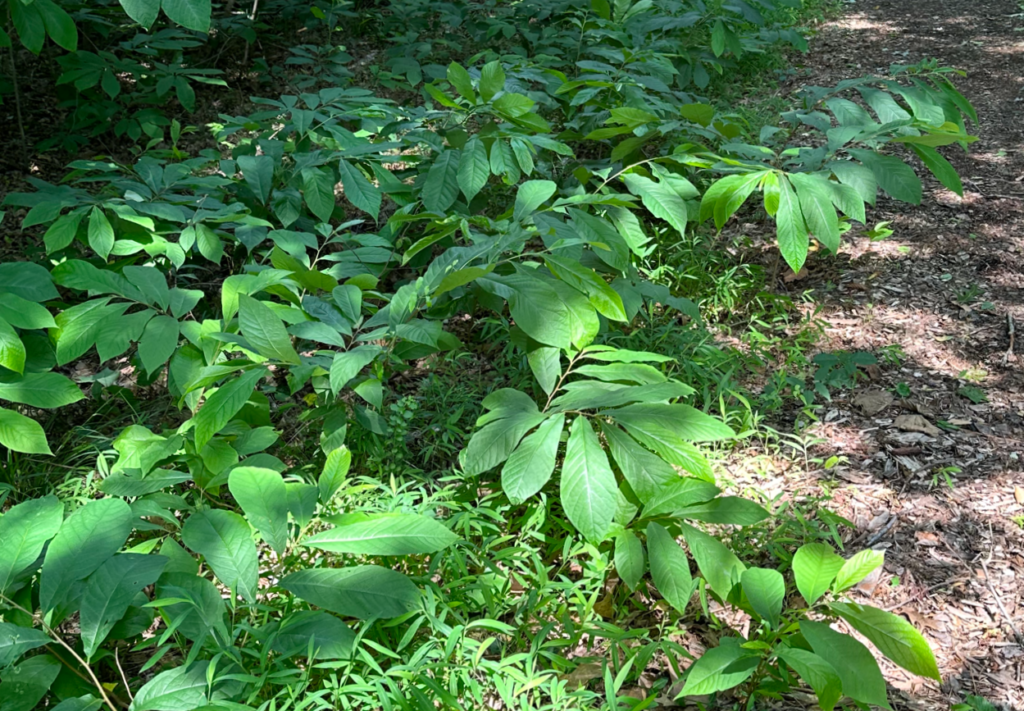
Pawpaw trees sucker and spread in the pawpaw patch at the Ford’s Colony Arboretum. Photo courtesy of Dave Kleppinger.
Appreciation to fellow Tree Stewards Dave Kleppinger and Rick Brown for their inspiration and contributions to this article.
All photos, unless otherwise credited, by E. L. McCoy
Learn More About Growing Pawpaw Trees
Cothron, Blake.
Judd, Michael.
Moore, Andrew and Michael W. Twitty.
A Few of the Many Suppliers of Named Pawpaw Trees
Edible Landscaping– Afton VA: https://ediblelandscaping.com
England’s Orchard and Nursery– McKee KY: http://www.nuttrees.net/
Nolin River Nut Tree Nursery– Upton KY: http://www.nolinnursery.com
Stark Bros.- Louisiana MO: https://www.starkbros.com
Shadow Nursery– Winchester TN: http://shadownursery.com

